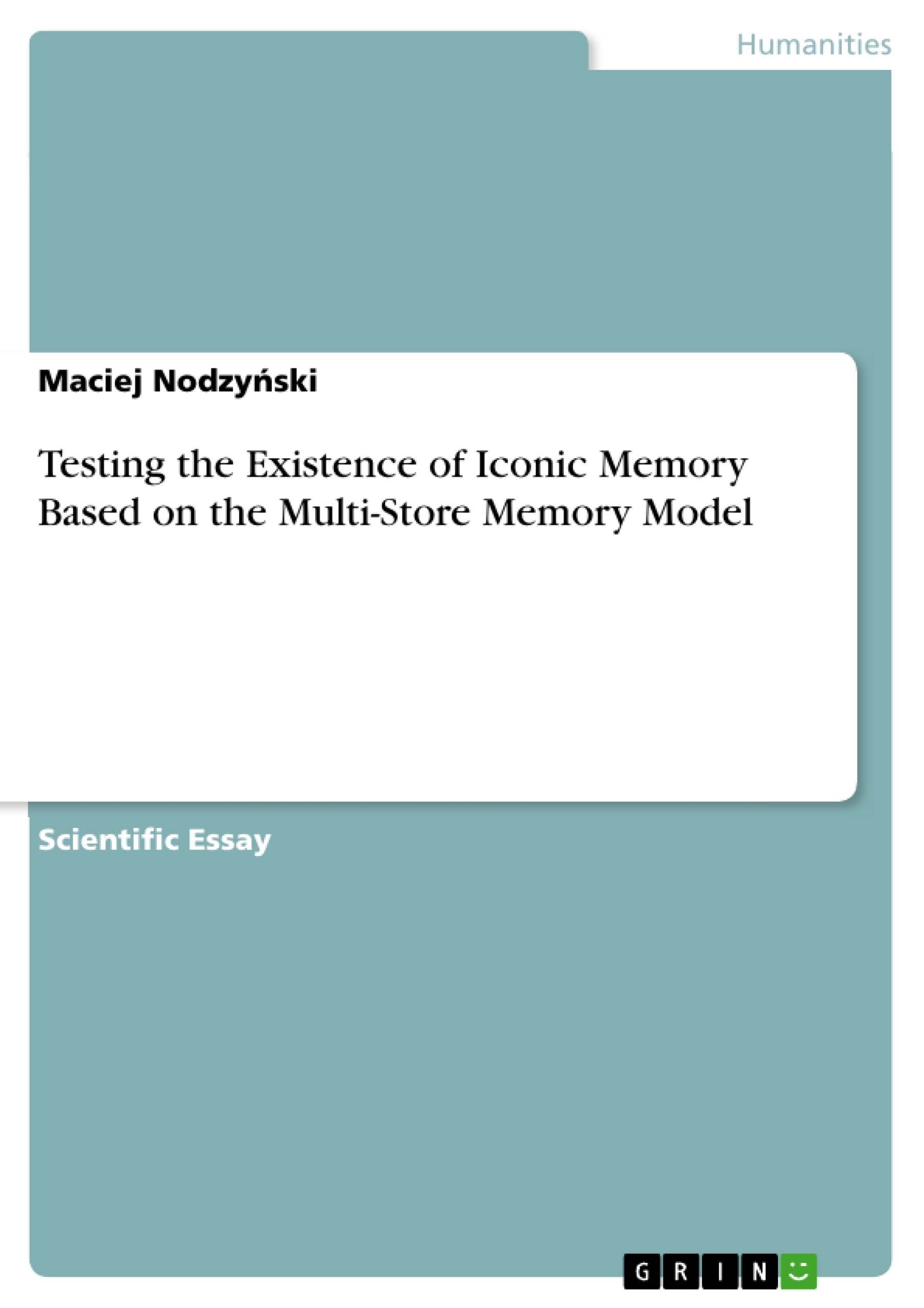This study wants to investigate the link between attention and the amount of information that can be held. This paper aims to test quantitatively the existence of iconic memory. The subject is relevant as it helps to understand how memory and its components work. According to the investigated model, iconic memory is a part of the first component of memory which information reaches. Moreover, it depends on sight which processes 83% of the stimulus so it is justified to extend the knowledge about this subject.
The theoretical prediction is that the amount of correctly recalled information will depend on paying attention. Attention will be operationalized as a partialreport condition, where participants had to remember 4 elements from the grid or whole-report condition where they were instructed to recall all, 12 elements from the grid. The amount of correctly recalled information is shown as the percentage of correctly recalled characters from a grid.
Table of Contents
- 1. Introduction
- 2. Exploration
- 2.1: Design and method
- 2.2: Participants
- 2.3: Materials
- 2.4 Procedure
- 2.5: Control variables
- 3. Analysis
Objectives and Key Themes
This paper aims to quantitatively test the existence of iconic memory, a component of the multi-store memory model. The study investigates the relationship between attention and the amount of information retained in iconic memory. The relevance stems from understanding the workings of memory and its components, particularly visual processing, which constitutes a significant portion of sensory input.
- The existence and capacity of iconic memory.
- The role of attention in transferring information from iconic memory to short-term memory.
- Quantitative analysis of memory performance under different attention conditions.
- Validation of the multi-store memory model.
- Comparison of results with Sperling's original study.
Chapter Summaries
1. Introduction: This chapter introduces the multi-store model of memory, focusing on iconic memory—its capacity, duration, and role in the memory process. It highlights the limited duration of iconic memory and the critical role of attention in transferring information to short-term memory. The chapter sets the stage by referencing Sperling's research on iconic memory, emphasizing the concept that "More is seen than can be remembered," and introducing the methodology of Sperling's experiments to compare the findings of the current research.
2. Exploration: This chapter details the methodology of the experiment designed to test the existence of iconic memory. It describes the repeated measures design, counterbalancing to mitigate order effects, and the online experimental setup due to pandemic restrictions. The chapter outlines participant selection (young Polish adults), materials (informed consent forms, briefing notes, alphanumeric grids, etc.), and the experimental procedure (whole-report and partial-report conditions with auditory cues). Careful consideration was given to control variables such as participant rest, quiet conditions, consistent grid configurations, and participant characteristics to minimize bias and ensure reliability.
3. Analysis: This chapter presents the results of the experiment. Descriptive statistics, including measures of central tendency (mean, median, mode) and dispersion (standard deviation), are used to analyze the data from both the whole-report and partial-report conditions. The chapter acknowledges the need to adjust data from the partial-report condition to account for reporting only a portion of the stimulus, as per Sperling's methodology. The provided table shows a clear difference between the whole-report and partial report conditions, indicating superior performance in the latter.
Keywords
Iconic memory, multi-store memory model, attention, short-term memory, sensory memory, visual perception, experimental psychology, quantitative research, Sperling, whole-report, partial-report.
Frequently Asked Questions: A Comprehensive Language Preview
What is the main topic of this research paper?
This research paper quantitatively investigates the existence and capacity of iconic memory, a component of the multi-store memory model. It specifically explores the relationship between attention and the amount of information retained in iconic memory, comparing findings to Sperling's original research.
What are the key objectives of the study?
The study aims to: 1) Test the existence and capacity of iconic memory; 2) Examine the role of attention in transferring information from iconic memory to short-term memory; 3) Quantitatively analyze memory performance under different attention conditions; 4) Validate aspects of the multi-store memory model; and 5) Compare results with Sperling's original study on iconic memory.
What methodology was used in the study?
The study employed a repeated measures design with counterbalancing to mitigate order effects. Data was collected using an online experimental setup due to pandemic restrictions. Participants were young Polish adults. Materials included informed consent forms, briefing notes, and alphanumeric grids. The procedure involved whole-report and partial-report conditions with auditory cues. Control variables were implemented to minimize bias and ensure reliability.
What are the key themes explored in the paper?
Key themes include the capacity and duration of iconic memory, the role of attention in memory processes, the validation of the multi-store model of memory, and a comparison with existing research (specifically Sperling's work).
How was the data analyzed?
The analysis involved descriptive statistics, including measures of central tendency (mean, median, mode) and dispersion (standard deviation). Data from the partial-report condition was adjusted to account for reporting only a portion of the stimulus, following Sperling's methodology. The results clearly differentiated the performance in whole-report and partial-report conditions.
What are the key findings of the study (as summarized)?
The results, presented in the analysis chapter, show a clear difference between the whole-report and partial-report conditions, indicating superior performance in the partial-report condition, supporting the existence and capacity of iconic memory and the influence of attention on its function.
What are the keywords associated with this research?
Keywords include: Iconic memory, multi-store memory model, attention, short-term memory, sensory memory, visual perception, experimental psychology, quantitative research, Sperling, whole-report, partial-report.
What is the structure of the paper?
The paper is structured into three main chapters: an introduction outlining the background and theoretical framework; an exploration section detailing the methodology; and an analysis section presenting the results and their interpretation.
- Quote paper
- Maciej Nodzyński (Author), 2021, Testing the Existence of Iconic Memory Based on the Multi-Store Memory Model, Munich, GRIN Verlag, https://www.grin.com/document/1059543




